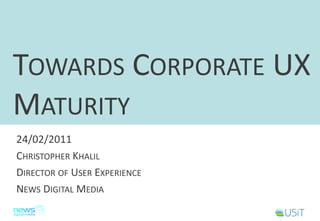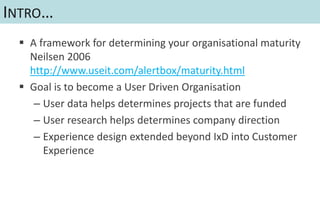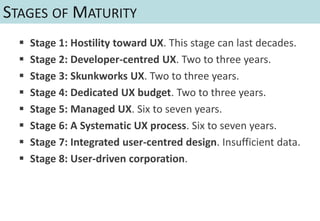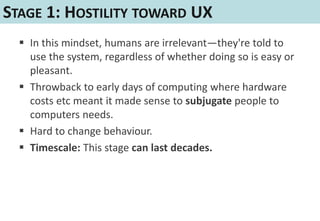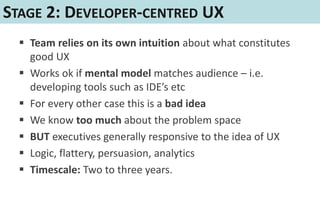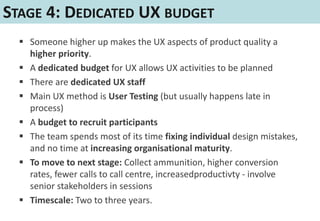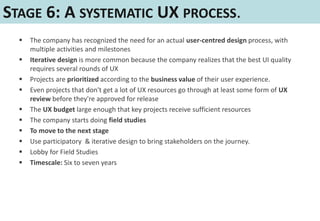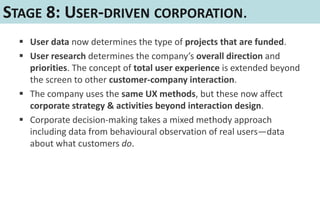Towards corporate usability maturity
- 1. TOWARDS CORPORATE UX MATURITY 24/02/2011 CHRISTOPHER KHALIL DIRECTOR OF USER EXPERIENCE NEWS DIGITAL MEDIA
- 2. INTROŌĆ” ’é¦ A framework for determining your organisational maturity Neilsen 2006 http://www.useit.com/alertbox/maturity.html ’é¦ Goal is to become a User Driven Organisation ŌĆō User data helps determines projects that are funded ŌĆō User research helps determines company direction ŌĆō Experience design extended beyond IxD into Customer Experience
- 3. STAGES OF MATURITY ’é¦ Stage 1: Hostility toward UX. This stage can last decades. ’é¦ Stage 2: Developer-centred UX. Two to three years. ’é¦ Stage 3: Skunkworks UX. Two to three years. ’é¦ Stage 4: Dedicated UX budget. Two to three years. ’é¦ Stage 5: Managed UX. Six to seven years. ’é¦ Stage 6: A Systematic UX process. Six to seven years. ’é¦ Stage 7: Integrated user-centred design. Insufficient data. ’é¦ Stage 8: User-driven corporation.
- 4. STAGE 1: HOSTILITY TOWARD UX ’é¦ In this mindset, humans are irrelevantŌĆöthey're told to use the system, regardless of whether doing so is easy or pleasant. ’é¦ Throwback to early days of computing where hardware costs etc meant it made sense to subjugate people to computers needs. ’é¦ Hard to change behaviour. ’é¦ Timescale: This stage can last decades.
- 5. STAGE 2: DEVELOPER-CENTRED UX ’é¦ Team relies on its own intuition about what constitutes good UX ’é¦ Works ok if mental model matches audience ŌĆō i.e. developing tools such as IDEŌĆÖs etc ’é¦ For every other case this is a bad idea ’é¦ We know too much about the problem space ’é¦ BUT executives generally responsive to the idea of UX ’é¦ Logic, flattery, persuasion, analytics ’é¦ Timescale: Two to three years.
- 6. STAGE 3: SKUNKWORKS UX. ’é¦ No official recognition of UX, nor is there an approved budget ’é¦ Organization realises need to be customer focused ’é¦ Guerrilla testing prevalent ’é¦ Activities are ad hoc and driven by UX advocates ’é¦ Primitive but effective skunkwork techniques employed ’é¦ Rely on results to progress: analytics, AB test, survey ’é¦ To prevent being overlooked, save the initial design ideas, clumsy as they may seem, and show before/after comparisons to document the UX advances. ’é¦ Timescale: Two to three years.
- 7. STAGE 4: DEDICATED UX BUDGET ’é¦ Someone higher up makes the UX aspects of product quality a higher priority. ’é¦ A dedicated budget for UX allows UX activities to be planned ’é¦ There are dedicated UX staff ’é¦ Main UX method is User Testing (but usually happens late in process) ’é¦ A budget to recruit participants ’é¦ The team spends most of its time fixing individual design mistakes, and no time at increasing organisational maturity. ’é¦ To move to next stage: Collect ammunition, higher conversion rates, fewer calls to call centre, increasedproductivty - involve senior stakeholders in sessions ’é¦ Timescale: Two to three years.
- 8. STAGE 5: MANAGED UX. ’é¦ Official UX group, led by Manager ’é¦ Studies are conducted more consistently as the UX group refines its methodology ’é¦ The group archives and compiles the findings of UX reports. ’é¦ The company has a person whose job it is to think about UX across the organization, in order to increase organisational maturity and leverage existing UX staff for more strategic purposes ’é¦ To move to next stage: Use budget on high profile projects aim for spectacular wins, evangelise, participatory design, involve senior stakeholders in sessions ’é¦ Timescale: Six to seven years
- 9. STAGE 6: A SYSTEMATIC UX PROCESS. ’é¦ The company has recognized the need for an actual user-centred design process, with multiple activities and milestones ’é¦ Iterative design is more common because the company realizes that the best UI quality requires several rounds of UX ’é¦ Projects are prioritized according to the business value of their user experience. ’é¦ Even projects that don't get a lot of UX resources go through at least some form of UX review before they're approved for release ’é¦ The UX budget large enough that key projects receive sufficient resources ’é¦ The company starts doing field studies ’é¦ To move to the next stage ’é¦ Use participatory & iterative design to bring stakeholders on the journey. ’é¦ Lobby for Field Studies ’é¦ Timescale: Six to seven years
- 10. STAGE 7: INTEGRATED USER-CENTRED DESIGN. ’é¦ Field studies, as a form of very early user research is in the DNA. ’é¦ Each step in the development process is infused with user data, including the project definition and the requirements phase. ’é¦ Beyond simply estimating user experience quality, the company tracks quality through quantitative UX metrics. ’é¦ Each project has defined UX goals that these measurements must surpass for the design to be greenlighted for release. ’é¦ The company begins to employ UX data to determine what it should build.
- 11. STAGE 8: USER-DRIVEN CORPORATION. ’é¦ User data now determines the type of projects that are funded. ’é¦ User research determines the companyŌĆÖs overall direction and priorities. The concept of total user experience is extended beyond the screen to other customer-company interaction. ’é¦ The company uses the same UX methods, but these now affect corporate strategy & activities beyond interaction design. ’é¦ Corporate decision-making takes a mixed methody approach including data from behavioural observation of real usersŌĆödata about what customers do.
- 12. CONCLUSION ’é¦ The timing obviously differs among organizations ’é¦ Start-ups are lucky and can begin the maturity process at stage 3 or stage 4 ’é¦ Steps must be addressed in order, hard to skip a stage ’é¦ Too many simultaneous changes are likely to result in failure ’é¦ Find the best ŌĆśbuttonsŌĆÖ in your organisation to press and keep punching them.

